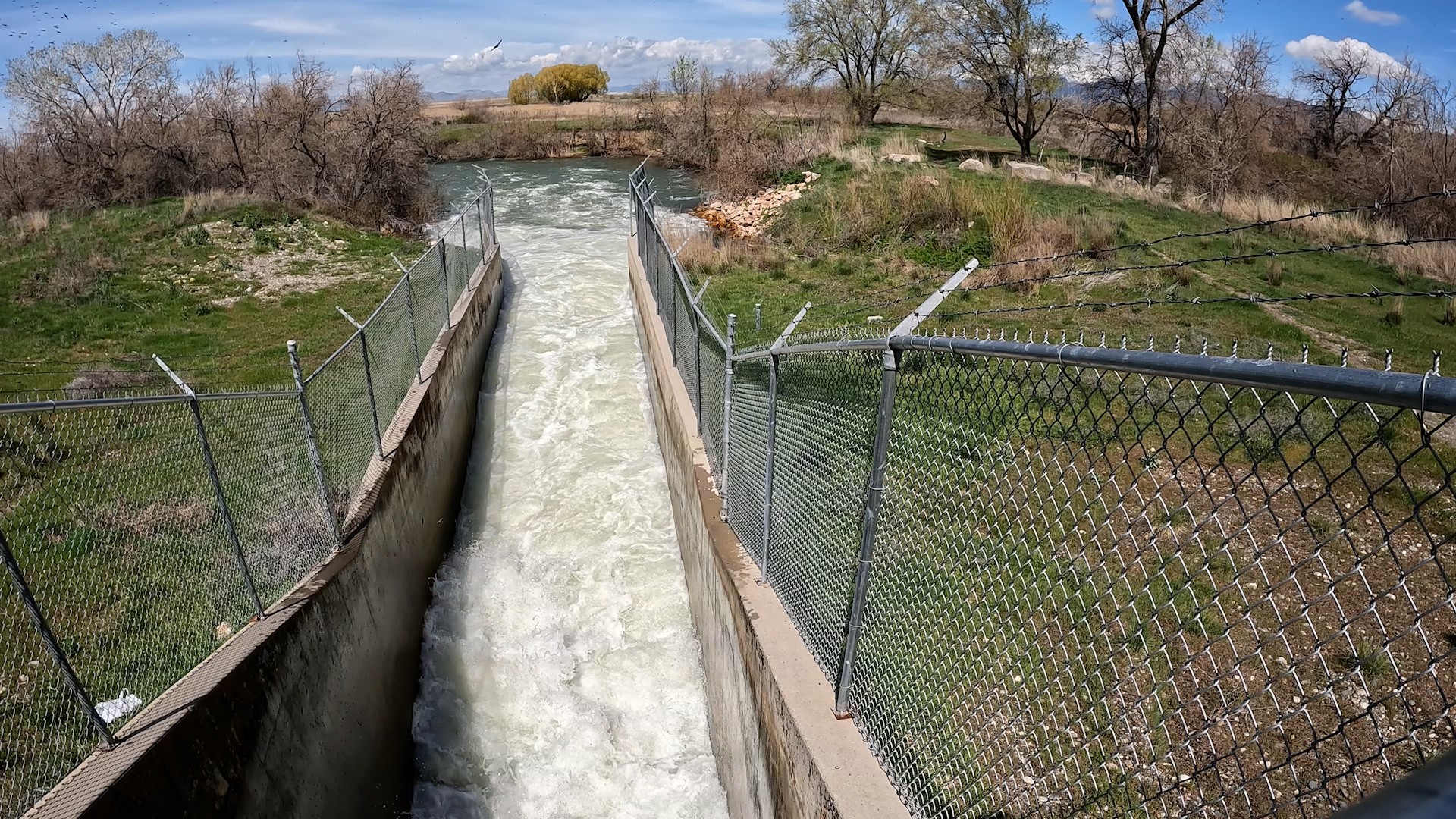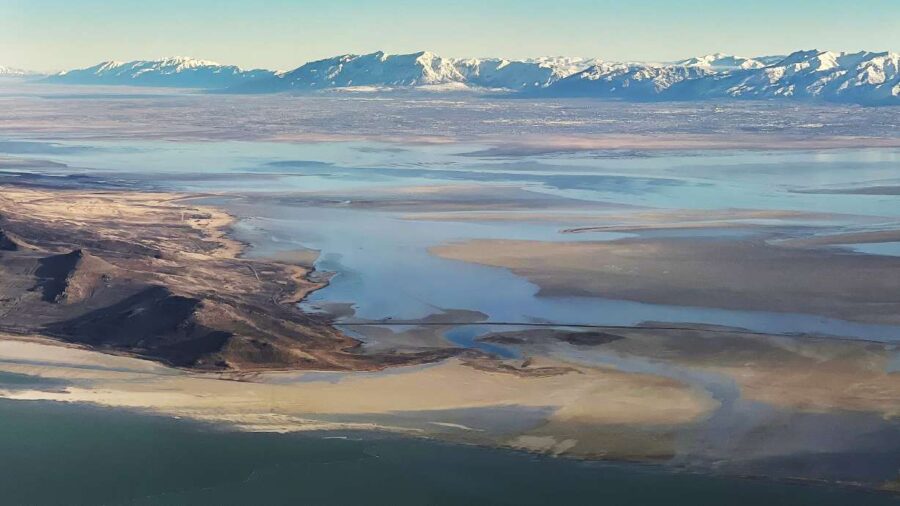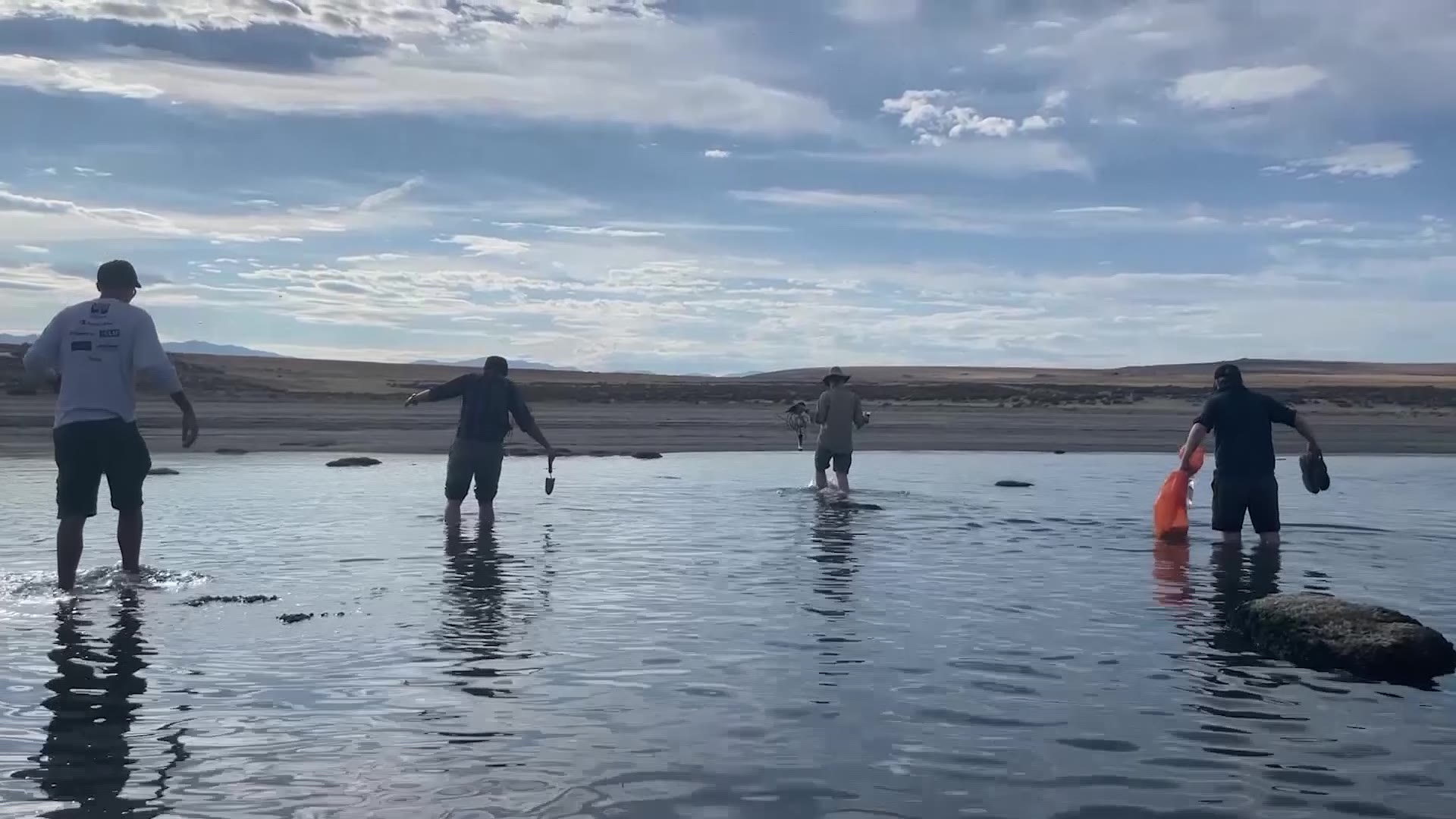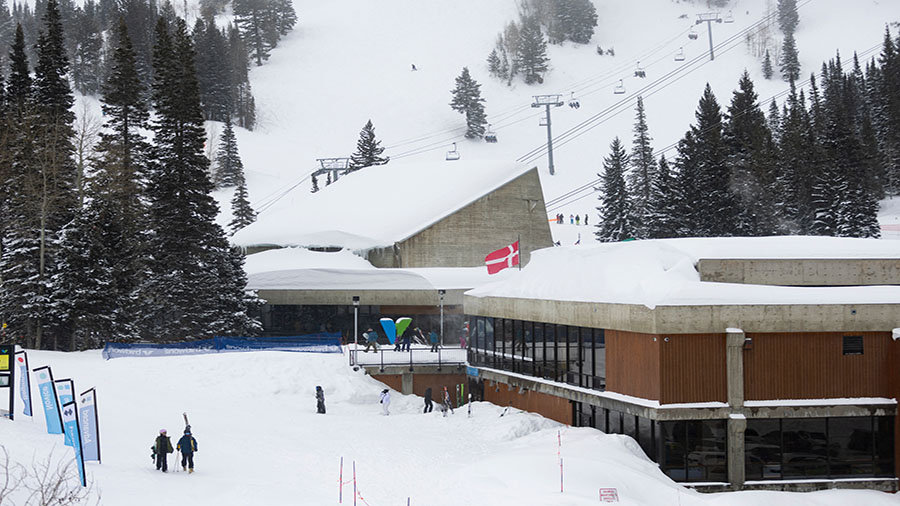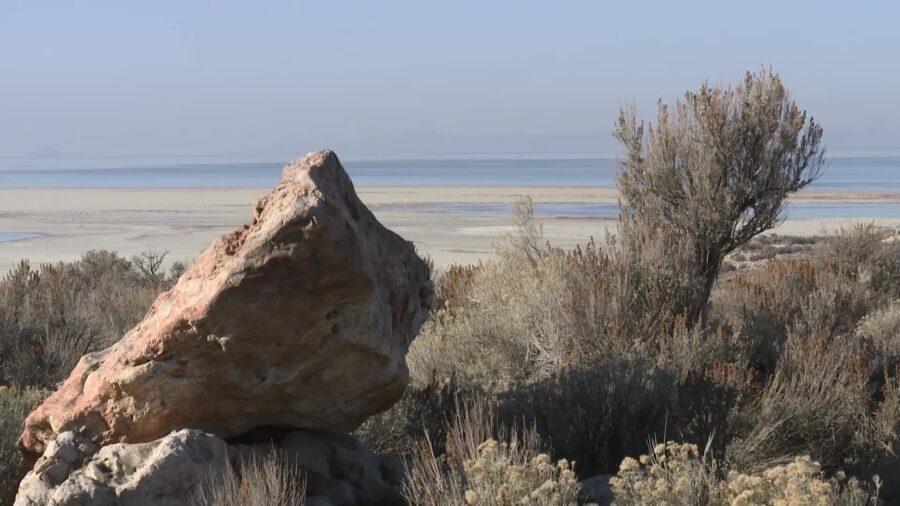Dust hot spots: Where is Great Salt Lake’s toxic dust most likely to originate?
Sep 21, 2022, 4:07 PM | Updated: Nov 18, 2022, 10:59 pm
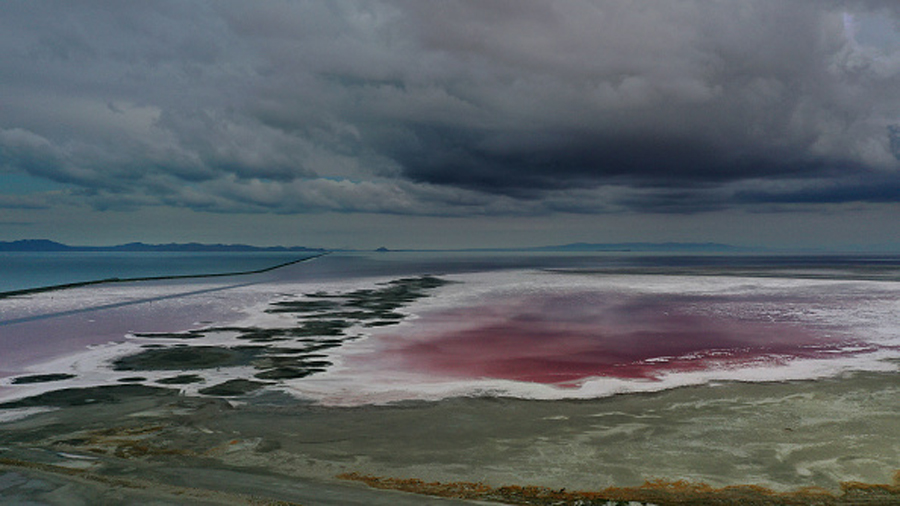
CORINNE, UTAH - AUGUST 02: In an aerial view, an evaporation pond is pinkish-red due to high salinity levels leaves a crust of salt on the north section of the Great Salt Lake on August 02, 2021 near Corinne, Utah. As severe drought continues to take hold in the western United States, water levels at the Great Salt Lake, the largest saltwater lake in the Western Hemisphere, have dropped to the lowest levels ever recorded. The lake fell below 4194.4 feet in the past week after years of decline from its highest level recorded in 1986 with 4211.65 feet. Further decline of the lake's water levels could result in an increase in water salinity and could generate dust from the exposed lakebed that could impact air quality in the area. The lake does not supply water or generate electricity for nearby communities but it does provide a natural habitat for migrating birds and other wildlife. According to the U.S. Drought Monitor, 99 percent of Utah is experiencing extreme drought conditions. (Photo by Justin Sullivan/Getty Images)
(Photo by Justin Sullivan/Getty Images)
Editor’s note: This article is published through the Great Salt Lake Collaborative, a solutions journalism initiative that partners news, education, and media organizations to help inform people about the plight of the Great Salt Lake — and what can be done to make a difference before it is too late.
SALT LAKE CITY — Kevin Perry believes there are many “trigger points” that indicate when there is something wrong with the Great Salt Lake.
For instance, anyone who has come to the lake for recreation has recently found an inability to launch watercraft as the lake levels continue to reach all-time lows. Struggles for the vital brine shrimp industry and a possible collapse of the lake’s base food chain are other alarms on the horizon, says Perry, a professor of atmospheric science at the University of Utah.
Toxic dust from the drying lakebed ultimately became one of the first alarms that captivated researchers, though. The Great Salt Lake contains arsenic and other metals that are naturally occurring, while some researchers say could even be human-caused. And as the lake shrinks, it has exposed some 800 square miles of exposed lakebed, equivalent to the entire surface area of Maui.
Researchers are starting to identify places around the dried-up lake that are most likely to produce dust that is ultimately carried into Utah communities, Perry says. He pinpoints Farmington Bay in Davis County, Bear River Bay near Brigham City and Ogden, and the lake’s northwest boundary in a remote part of Box Elder County as the three largest dust “hot spots.”
These three locations have the highest potential of sourcing dust all over northern Utah for years to come unless there’s a dramatic turnaround in the lake levels, Perry explained Tuesday evening in a presentation about dust concerns to the Utah Legislature’s bipartisan Clean Air Caucus.
But before rushing into a panic, Perry told lawmakers there is still so much more research needed to fully understand the dust carried out of the dried Great Salt Lake, including if and how much of a role it plays in long-term health concerns.
The dust hot spots
There are certain spots within the 800 square miles of exposed lakebed with a higher potential to produce dust that is carried into Utah communities during storms. While winds typically impact areas east of the lake, like Wasatch Front communities, weather patterns can blow the dust into areas all over northern Utah.
“Everybody along the Wasatch Front (and Tooele Valley) is impacted at certain times,” Perry said after Tuesday’s meeting.
Perry’s research over the years has focused on identifying the frequency that dust is exposed in the atmosphere and also the concentration levels of dust in the air that Utahns breathe to understand public health impacts. It’s helped him figure out the areas where dust is more likely to be picked up.
Soil with higher amounts of erodible material like silt and clay are more likely to be picked up into the air. Farmington Bay, Bear River Bay and the “extreme” northwest quadrant of the lake have the highest levels of silt and clay of any exposed lakebeds, where the materials make up at least 10% of the soil samples. Most of it arrives from the lake’s tributaries like the Jordan, Bear and Weber rivers.
They are the same areas where the lake’s surface crust is vulnerable. Perry explains that only about 9% of the lakebed is actively producing dust because three-fourths of the lake is currently protected by a crust, such as the natural salt pan that protects the lakebed from breaking.
The dust coming from the remaining quarter either doesn’t have crust or the crust is considered erodible. Human activity from illegal motor vehicle riding on the exposed lakebed is one reason for this crust breaking, and dust can blow freely in the wind once the surface erodes.
Again, Farmington and Bear River bays emerge as hot spots, as well as Gilbert and Gunnison bays on the western corners of the lake. And while most of the lakebed is protected now, the amount of protection decreases every year it is exposed because of how fragile the crust is, Perry adds.
The air quality ‘threat’
This dust is a problem just because of its ability to raise particulate matter levels, something Utahns are accustomed to hearing about from wildfires and during winter inversions that threaten Utah’s air quality. But Perry cautions it is too early to know what the true human impact of the dust will be.
The lakebed contains levels of arsenic, lanthanum, lithium, zirconium, copper, and other metals above the Environmental Protection Agency’s residential and industrial standards. Of those, arsenic, which can increase the risk of a few diseases when there is chronic exposure, has the highest levels compared to EPA standards, according to Perry.
However, it is not very clear how much of it people are actually breathing in during a wind event. The dose levels, a calculation of concentration, frequency and bioavailability, are needed to fully understand the true human risk associated.
This data is collected by the Utah Division of Air Quality but Perry says it hasn’t been analyzed to this point because of the cost: $27,500 per site annually. Until that is available, researchers don’t really know any component in the dose level equation, including how many days of the year dust ends up in surrounding communities or if some communities have disparities compared to others.
This is why Perry emphasizes that what is in the dust should be considered a “potential concern.” He likens this uncertainty to driving on an unfamiliar mountain road in the dark. Motorists are more likely to slow down and focus on the road ahead of them when they perceive a risk of driving off the roadway.
The same idea applies to the science of the Great Salt Lake.
“What we’ve done here is identify a risk,” Perry says. “The risk is exposure to (the) heavy metal arsenic, and so what we need to do is step back and try and understand the significance of that risk. … We need to do more research, we need to take more measurements but we need to be vigilant because there is a threat out there. We need to determine if that threat will be realized or not.”
The easiest solution
But how does Utah avoid this potential concern? The easiest solution is refilling the lake, though, that’s still a daunting task considering all the upstream water diversions that take water out of the lake and that Utah is in the middle of a two-decade-long megadrought. This says everything about how challenging it is to mitigate dust once a lakebed is exposed.
There are dozens of global examples of what can go wrong when a lake dries out but Owens Lake in California is the one that Perry pointed lawmakers to on Tuesday. The lake began to dry up when Los Angeles officials began diverting the lake’s water sources into the Los Angeles Aqueduct.
California leaders have since spent over $2 billion trying to mitigate the health concerns associated with the dried lake dust. They eventually determined the only feasible solution was to refill the lake, Perry explains.
This solution could take a long time to solve Utah’s problems, though. Of the Great Salt Lake’s four major concern areas, Perry considers Farmington Bay as the easiest to mitigate simply because it requires the least amount of water to help cover the surface area. The lake needs to gain about 10 feet of water to mitigate dust concerns in the bay, but that could take decades to happen, barring an unforeseen shift in trends.
“Which means that we’re going to be plagued by dust coming off the Great Salt Lake not just for a few years but likely for decades,” he said.
That said, he’s more optimistic about this solution now than just three years ago. He’s seen Utahns show more interest in reducing water waste and state leaders take larger steps toward water conservation compared to the past. Tuesday’s meeting featured four experts explaining ways to improve water quantity and air quality around the lake.
Ward agrees that the state is going to need to more than just refill the lake once to resolve the lake’s issue. The Utah Legislature directed $40 million toward getting more water to the lake in this year’s legislative session. More money and projects are needed to ensure water is flowing to the Great Salt Lake, Ward acknowledges.
But it’s time and money worth spending given the known and potential risks Utah faces as the lake dries up.
“The big picture is we’re in trouble with the lake right now,” he said. “This is not a problem that might happen in the future, the lake is three-fourths of the way gone today and we really, really need to have a sustained focus on it over a longer period of time to … make sure we put enough water into it.”


